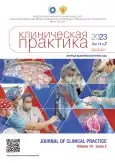Features of therapeutic tactics for the failure of gastrointestinal anastomosis in patients with morbid obesity after Roux-en-Y gastric bypass
- Authors: Stankevich V.R.1, Smirnov A.V.1, Zlobin A.I.1,2, Panchenkov D.N.1,2, Danilina E.S.1, Ivanov Y.V.1,2
-
Affiliations:
- Federal Scientific and Clinical Center for Specialized Medical Assistance and Medical Technologies
- Moscow State University of Medicine and Dentistry named after A.I. Evdokimov
- Issue: Vol 14, No 2 (2023)
- Pages: 19-27
- Section: Original Study Articles
- URL: https://journals.rcsi.science/clinpractice/article/view/142788
- DOI: https://doi.org/10.17816/clinpract117516
- ID: 142788
Cite item
Full Text
Abstract
Background: Roux-en-Y gastric bypass is the main type of bariatric surgery. The most formidable and severe complication in morbid obesity patients after gastric bypass is gastrojejunostomy leak.
Aim: to study the possibilities of improving treatment outcomes of obese patients during gastrojejunostomy leak after gastric bypass surgery using new minimally invasive methods.
Methods: This retrospective cohort descriptive study included all patients with gastrojejunostomy leak after gastric bypass treated in the Department of Surgery of the Federal State Budgetary Institution Federal Scientific and Practical Center of the Federal Medical and Biological Agency of Russia in 2019–2022. In total, 445 gastric bypasses were performed during this period, and seven patients (1.6%) developed HEA failure in the postoperative period.
Results: The results of treatment of gastroenteroanastomotic leaks during gastric bypass in patients with morbid obesity are presented. The early diagnosis of gastroenteroanastomosis failure in this category of patients was difficult. All doubts in the diagnosis of anastomotic failure should be completed by revision laparoscopy with intraoperative esophagogastroscopy. Minimally invasive techniques (surgical, endoscopic), drug therapy, and adequate nutritional support are crucial for managing patients with anastomotic leaks.
Conclusion: The use of an endoscopic intraluminal vacuum aspiration system in the treatment of gastroenteroanastomotic insufficiency avoids the spread of inflammation in the abdominal cavity, accelerates the reparative process in the area of insufficiency, and, in most cases, avoids programmed sanitation, significantly improving the treatment results.
Full Text
##article.viewOnOriginalSite##About the authors
Vladimir R. Stankevich
Federal Scientific and Clinical Center for Specialized Medical Assistance and Medical Technologies
Author for correspondence.
Email: v-stankevich@yandex.ru
ORCID iD: 0000-0002-8620-8755
SPIN-code: 5126-6092
MD, PhD
Russian Federation, MoscowAlexander V. Smirnov
Federal Scientific and Clinical Center for Specialized Medical Assistance and Medical Technologies
Email: alvsmirnov@mail.ru
ORCID iD: 0000-0003-3897-8306
SPIN-code: 5619-1151
MD, PhD
Russian Federation, MoscowAlexandr I. Zlobin
Federal Scientific and Clinical Center for Specialized Medical Assistance and Medical Technologies; Moscow State University of Medicine and Dentistry named after A.I. Evdokimov
Email: sancho-83@inbox.ru
ORCID iD: 0000-0002-8241-659X
SPIN-code: 2894-5059
MD, PhD
Russian Federation, Moscow; MoscowDmitry N. Panchenkov
Federal Scientific and Clinical Center for Specialized Medical Assistance and Medical Technologies; Moscow State University of Medicine and Dentistry named after A.I. Evdokimov
Email: dnpanchenkov@mail.ru
ORCID iD: 0000-0001-8539-4392
SPIN-code: 4316-4651
Dr. Sci. (Med.), Professor
Russian Federation, Moscow; MoscowEkaterina S. Danilina
Federal Scientific and Clinical Center for Specialized Medical Assistance and Medical Technologies
Email: danilina.katja@bk.ru
ORCID iD: 0000-0002-2466-3795
Russian Federation, Moscow
Yury V. Ivanov
Federal Scientific and Clinical Center for Specialized Medical Assistance and Medical Technologies; Moscow State University of Medicine and Dentistry named after A.I. Evdokimov
Email: ivanovkb83@yandex.ru
ORCID iD: 0000-0001-6209-4194
SPIN-code: 3240-4335
Dr. Sci. (Med.), Professor
Russian Federation, Moscow; MoscowReferences
- Borraez-Segura B, Orozco-Hernández JP, Anduquia-Garay F, et al. Increase in C-reactive protein as early predictor of anastomotic leakage in abdominal surgery. Cir Cir. 2022;90(6): 759–764. doi: 10.24875/CIRU.21000597
- Mocanu V, Dang J, Ladak F, et al. Predictors and outcomes of leak after Roux-en-Y gastric bypass: An analysis of the MBSAQIP data registry. Surg Obes Relat Dis. 2019;15(3): 396–403. doi: 10.1016/j.soard.2019.01.012
- Spyropoulos C, Argentou MI, Petsas T, et al. Management of gastrointestinal leaks after surgery for clinically severe obesity. Surg Obes Relat Dis. 2012;8(5):609–615. doi: 10.1016/j.soard.2011.04.222
- Blackmon SH, Santora R, Schwarz P, et al. Utility of removable esophageal covered self-expanding metal stents for leak and fistula management. Ann Thorac Surg. 2010;89(3):931–936. doi: 10.1016/j.athoracsur.2009.10.061
- Scavone G, Caltabiano G, Inì C, et al. Radiological stent placement of post sleeve gastrectomy leak: Efficacy, imaging features and post-procedure complications. Heliyon. 2022;8(1): e08857. doi: 10.1016/j.heliyon.2022.e08857
- Hirdes MM, Vleggaar FP, van der Linde K, et al. Esophageal perforation due to removal of partially covered self-expanding metal stents placed for a benign perforation or leak. Endoscopy. 2011;43(2):156–159. doi: 10.1055/s-0030-1255849
- Norman G, Shi C, Goh EL, et al. Negative pressure wound therapy for surgical wounds healing by primary closure. Cochrane Database Sys Rev. 2020;6(6):CD009261. doi: 10.1002/14651858.CD009261.pub6
- Markus A, Henrik BJ, Benedikt R, et al. Endoscopic vacuum therapy in salvage and standalone treatment of gastric leaks after bariatric surgery. Langenbecks Arch Surg. 2022;407(3): 1039–1046. doi: 10.1007/s00423-021-02365-9
- Cipolla J, Baillie DR, Steinberg SM, et al. Negative pressure wound therapy: Unusual and innovative applications. OPUS 12 Scientist. 2008;2(3):15–29.
- Cheng Y, Wang K, Gong J, et al. Negative pressure wound therapy for managing the open abdomen in non-trauma patients. Cochrane Database Syst Rev. 2022;5(5):CD013710. doi: 10.1002/14651858.CD013710.pub2
- Morell B, Murray F, Vetter D, et al. Endoscopic vacuum therapy (EVT) for early infradiaphragmal leakage after bariatric surgery-outcomes of six consecutive cases in a single institution. Langenbecks Arch Surg. 2019;404(1):115–121. doi: 10.1007/s00423-019-01750-9
- Scott RB, Ritter LA, Shada AL, et al. Endoluminal vacuum therapy for gastrojejunal anastomotic leaks after Roux-en-Y gastric bypass: A pilot study in a swine model. Surg Endosc. 2016;30(11):5147–5152. doi: 10.1007/s00464-016-4823-z
Supplementary files









